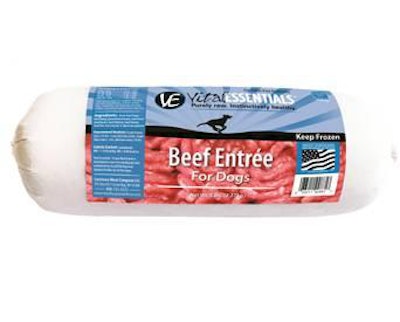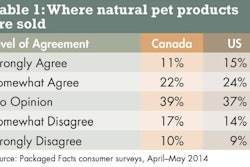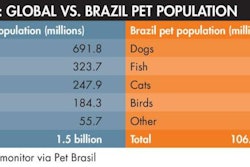
The idea of raw petfood has had its share of detractors in recent years. In June 2014, Colorado State University veterinarians came out against feeding pets raw diets, citing increased risks for contamination and the dangers of nutritionally imbalanced diets. The next month, the US Food and Drug Administration (FDA) presented warnings of its own, highlighting the possibility for food poisoning in both pets and their owners. The American Veterinary Medical Association (AVMA)’s current policy on raw or undercooked animal-source protein in petfood “discourages the feeding to cats and dogs of any animal-source protein that has not first been subjected to a process to eliminate pathogens because of the risk of illness to cats and dogs as well as humans.”
On the other hand, proponents of the raw petfood diet say that pets would thrive on a biologically appropriate diet, based on what they ate before they became domesticated (e.g., raw, meaty bones and vegetable scraps). Potential benefits can include shinier coats, healthier skin, cleaner teeth and higher energy levels. Some say that the current warnings lump all raw petfood together under a single definition, when in fact commercially prepared raw petfoods can be found under the categories of fresh, refrigerated, frozen or freeze-dried petfoods.
Studies on the subject of raw petfood seem to go both ways, as well. While some highlight the higher possibility for pathogen contamination compared to cooked (e.g., kibble) diets, others claim raw diets are more digestible for pets. But whatever the controversy, there’s no doubting these categories are on the rise in the industry. According to research company GfK, premium petfood products continue to drive profit growth in pet retail, growing 9.2% from 2011 to 2012 and 6.5% from 2012 to 2013. More specifically, freeze-dried products are on a significant upswing, seeing 74% growth since the first quarter of 2012. This increase beats out even the next most popular premium niche, grain-free, which has grown 64% in the same timeframe.
Refrigerated petfood diets have also seen consistent growth over the last few years (see Figure 1), bringing US$92 million to the petfood industry in 2013 (compared to just US$34 million in 2011, according to GfK). Within that segment, bagged food accounted for 47.9% of sales in 2013, while chubs and food rolls accounted for another 43.4% of sales.
Petfood companies that deal in the raw segment (or its related categories) are taking advantage of these still-growing numbers by expanding their lines while others have started to look to it as a new business opportunity. Bravo (www.BravoPetFoods.com), for example, has expanded its raw petfood products with its line of Homestyle Complete Dinners for Dogs—strong category growth led to the expansion, according to the company. The recipes include a selection of premium meat or poultry as the number one ingredient, and come in turkey, beef or pork.
Buddy’s Kitchen (www.buddyskitchen.ca) is expanding into a specific niche within the raw petfood market, into the prescription diet possibilities, with FreshRx, a fresh, frozen petfood line available only through veterinarians in Canada. FreshRx is a balanced maintenance diet, but can also be used as a supplement over a kibble diet to add nutrients, variety and increased palatability.
Nature’s Variety (www.naturesvariety.com) has both revamped its visual appeal and taken steps to further grow in the market. In May 2014 the company presented a new look to its Instinct Raw line, with enhanced packaging and formula updates with higher protein and lower fat, specialty ingredients for cats and dogs and single-source proteins such as the company's latest Raw Turkey diet. In July 2014, Nature’s Variety announced a partnership with Agrolimen, a Spanish group specializing in consumer goods and with brands in the petfood and food industries. Nature’s Variety has said that the new joint venture will help expand the company’s role in the raw petfood category, as well as support its commitment to pet parents in an even greater way going forward.
Stella & Chewy’s (www.stellaandchewys.com) has introduced Meal Mixers, positioned as a complement to an existing kibble diet and a way to introduce a new audience of dog owners to freeze-dried food. There are four varieties of Mixers, which can be mixed in with kibble (e.g., used as a "topper"): Super Beef, Chewy's Chicken, Tantalizing Turkey and Savory Salmon & Cod. Stella & Chewy's is also making moves on the expansion front, breaking ground in June 2014 on a new, 164,000-square-foot headquarters in Oak Creek, Wisconsin. The new building will replace the current headquarters in Milwaukee, Wisconsin, and is expected to open in 2015.
Vital Essentials (www.VitalEssentialsRaw.com) is making sure its customers can get more of the raw formulas it provides, releasing select frozen RAW entrées in 5-pound chub packaging in response to dog owner requests for larger package sizes. Catered to high-consumption dog families, the packs are available in three proteins—beef, chicken and duck.
Whether petfood companies have been in the raw segment for years or are just now entering the market, it’s clear that they all see the same thing—the niche is continuing to grow, and stands as a promising opportunity for those looking to expand their petfood reach.
















